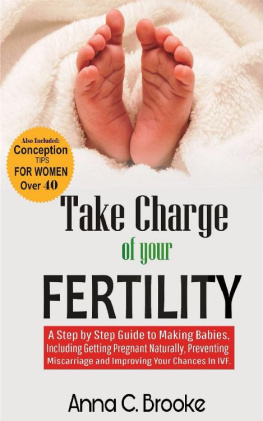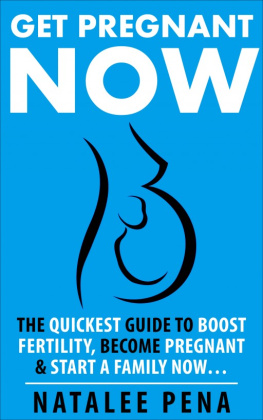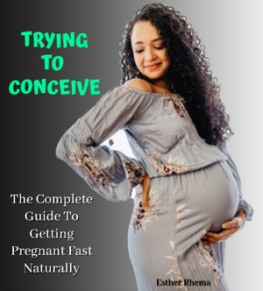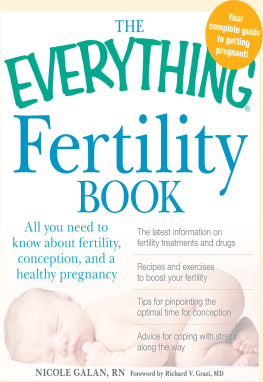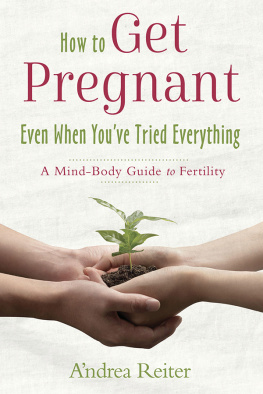GETTING
PREGNANT
naturally
Healthy Choices to
Boost Your Chances
of Conceiving without
Fertility Drugs
W INIFRED C ONKLING

For Hannah and Ella

Contents

I dont like the word infertility; it leaves no room for hope, even though many couples who have trouble conceiving go on to have children. I have known women with ovulation disorders and damaged tubes who became pregnant; I have known men with one-sided varicoceles and low sperm counts who have impregnated their wives. Instead of using the word infertile, I prefer to use the term impaired fertility. I have worked with hundreds of couples with impaired fertility, and I know that there are many things couples can do to enhance their chances of conceiving a child. Human reproduction is an inexact science; most people shift back and forth between periods of fertility and infertility as their bodies pass through various hormonal stages and respond to physical and emotional stresses. Our hormonesand our fertilitychange in response to age, diet, and nutrition, and exercise and lifestyle, among other factors. Some of these factors we can control, others we cannot. When it comes to getting pregnant, its up to you to make the most of each month. Its up to you to eat right, to rest, and to make healthy choices in your life. Its up to you to listen to your body; nobody knows your body better than you do. You must learn to recognize when something feels off so that you can follow up with a doctor. If you are a man, its up to you to protect your sperm. Most men dont realize that it takes almost three months to produce sperm, so that what you do today will affect your sperm months later. If you are a woman, its up to you to learn how to chart your fertility so that you can better time intercourse to coincide with ovulation. A simple temperature chart can also help you detect common fertility problems, such as a luteal phase defect. In many cases, no single thing you do or dont do determines your fertility. It is the cumulative effect of a number of little things that can either enhance or impair your fertility. This is why you should do what you can to get pregnant naturally before you rush off to consult a reproductive endocrinologist. The advice offered in this book can help you increase your chances of conceiving a child. If you remain childless after a year, you may need to work with a fertility specialist. Of course, you may do everything right and still end up without a biological child. I spent nine years trying to get pregnant, and I tried everything you can imagine. Thats why I never ask anyone I meet, How many children do you have? I remember what a difficult question that was to answer when my husband and I were trying desperately to conceive. I am now the mother of two adopted children. Once I accepted that my body was not going to reproduce and that my husband and I were not going to build a family the way that we had hoped, dreamed, and planned, I realized that adoption offered another option. While adoption was my second choice, it was not second-best. I have been blessed with two wonderful children. I am a mother. My husband and I have built our family. I have everything but a pregnancy story. Best of luck to those of you entering this journey. I LENE S TARGOT
Founder and Executive Director
National Infertility Network Exchange (NINE)

I ts ironic: When couples dont want to have a baby, they assume that they are fertile and put a lot of energy into preventing pregnancy. Then, when they decide its time to start a family, they suddenly appreciate how difficult it actually is to conceive a child.
Getting pregnant requires exquisite timing, a balanced hormonal system, good general healthand a measure of good fortune. A womans endocrine system must release precise levels of hormones at specific times during her menstrual cycle. Her ovaries must produce and release at least one mature and healthy egg follicle, and that egg must be able to make its way through the Fallopian tubes toward a welcoming uterus. A mans reproductive system must produce semen containing an abundant supply of healthy sperm ready to swim eagerly toward the intended target. The womans cervix must produce enough mucus to protect the sperm and hurry them into the uterus and Fallopian tubes. Once the egg and sperm have been united, the thickened uterine lining must be responsive and ready to nourish the fertilized egg after it has implanted.
A single missed cue or minor glitch, and the system doesnt work. Considering the complexities, its no wonder that a healthy and fertile couple stands only a 20 percent chance of conceiving a child in any given month. It also explains why more than 5 million Americans of childbearing age are considered technically infertile, meaning they have tried to conceive a child for one year or more without success.
But there is hope. As many as half of all infertile couples do go on to get pregnant and have healthy babies. These couples could more accurately be defined as subfertile . They may not suffer from a physical problem that prevents conception, but it may take them longer than one year to become pregnant. For these couples, the stork may arrive sooner if Mother Nature is offered a little extra help.
UNDERSTANDING INFERTILITY
Most couples who want to have children are successfulsome sooner, some later. Typically, half of the couples who decide to stop using contraception will conceive within three to five months, and about 85 percent of the couples will conceive within a year. However, that leaves 15 percentor roughly one out of every six coupleswho will experience fertility problems.
Impaired fertility has many causes. For about 35 to 40 percent of couples, the problem lies within the woman; for another 35 to 40 percent, the problem lies within the man; and in the rest, both partners have a problem or the cause is unknown.
Among women, hormonal imbalance is the most common cause of infertility. Other possible causes include scarring or obstruction of the Fallopian tubes, an allergic reaction to sperm, endometriosis, hostile cervical mucus, chromosomal abnormalities, a prolapsed uterus, fibroids, or physical injury to reproductive organs, among other causes. And, of course, age plays a significant role: A womans fertility peaks in her mid-twenties; her fertility declines gradually until age thirty, and then begins to fall off more rapidly. Many women remain fertile into their forties, but conception becomes more difficult with each passing year.
Among men, abnormal spermeither low sperm count or inferior sperm qualityis to blame for most fertility problems. It may take only one sperm to fertilize an egg, but the average ejaculation contains between 40 million and 150 million sperm. Most of these sperm dont stand a fighting chance of getting within striking distance of the awaiting egg; some 80 to 90 percent of them are killed off by vaginal fluids. Due to this intense screening process, men who ejaculate fewer than 60 million sperm may have difficulty impregnating their partners. In medical terminology, oligospermia means low sperm count and azoospermia means the absence of living sperm in the semen.
Next page




